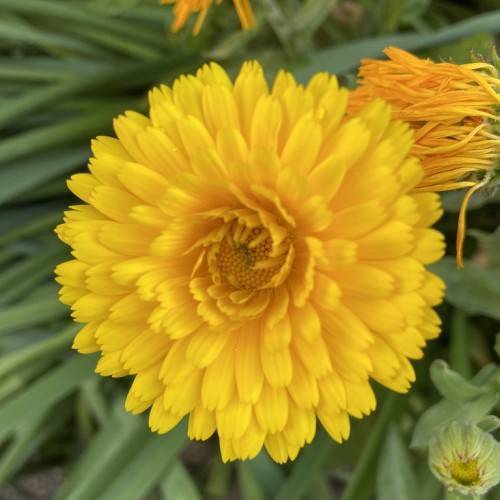
marigold
Calendula officinalis
Cycle:
Annual
Watering:
Average
Hardiness Zone:
2 - 11
Flowers:
Flowers
Sun:
full sun
Fruits:
Fruits Ready In Fall
Leaf:
Yes
Growth Rate:
Low
Maintenance:
Moderate
Salt Tolerant:
Yes
Care Level:
Medium
watering
Water Marigolds (Calendula officinalis) moderately. On particularly hot days, water more frequently - up to 3 times a week. Watering should be done early in the morning so that the plant has time to dry off before the evening. During the hotter months, deeper waterings will help promote full root development and flowering. Once soil is worked into the plant’s root system, it is important to be consistent with waterings.
sunlight
Marigolds (Calendula officinalis) thrive when they receive 8-10 hours of direct sunlight per day. They should be planted in an area that receives full sun, where they’ll enjoy bright, direct light from morning to mid-afternoon. Avoid providing too much shade, as that will discourage blooms and cause the plants to become spindly. Aim for a consistent and reliable amount of sunshine to ensure that marigolds grow and bloom properly throughout the growing season.
pruning
Marigold (Calendula officinalis) benefits from regular pruning for optimal health. Pruning can prevent overgrowth and encourage new flower growth. In general, the best time to prune Marigold is in the late summer or early fall. This is when the plant has started to slow down its growth and will be preparing for winter dormancy. Pruning should be done in moderation as too much can result in decreased flowering. Before pruning, wait for flowers to go to seed and the foliage to turn yellow. When pruning, use sharp gardening scissors or shears and remove up to 1-third of the plant’s foliage. This includes small stems, leaves, and flower heads. After pruning, feed the plant with an all-purpose fertilizer to encourage new flower growth.
Season
Hardiness Map
FAQ
Is the Marigold a popular annual flower?
Yes, the Marigold is a very popular annual flower. It is known for its attractive, bright orange and yellow blooms and its easy-to-grow nature. It is often planted as a border plant, as its hardy nature can tolerate both drought and full sun. The Marigold is also very attractive to beneficial insects, making it useful in integrated pest management practices. Marigold is a popular choice for container gardening and makes for a great addition to cottage gardens, as it is both colorful and fragrant.
Are Marigolds available in a variety of colors?
Yes, Marigolds are available in a variety of colors. Typically, Marigolds range from an orange, yellow, or white hue. However, there are many other shades of Marigolds, such as red, deep orange, bicolor, and even purple. The type of Marigold that you choose for your garden typically depends on the effect that you are hoping to create and the color palette of the surrounding plants.
Can Marigolds be grown from seeds?
Yes, marigolds can be grown from seeds. There are a wide range of marigold varieties that can be grown from seeds and they are typically quite easy to cultivate. Marigolds are annual plants that are often grown as bedding plants or in containers, and they can be started from seed indoors or planted directly into the ground outdoors. Many marigolds will produce flowers throughout the summer months, until the first frost. When regrow seeds, start planting indoors anywhere from 6 to 8 weeks before the last frost date for the area, and be sure to provide plenty of heat and light for the seedlings to grow.
Could Marigolds be used as border plants?
Yes, marigolds can be used as border plants for gardens, patios, and walkways. Marigolds are easy to grow and spread quickly, even in areas with poor soil and minimal sunlight. They come in shades of yellow, orange, and red, adding a cheery burst of color to any outdoor space. Marigolds also act as a natural pest repellant, as their strong scent can keep away a variety of insects that can damage plants. The flowers also attract beneficial insects like bees and butterflies. With proper maintenance, border-planted marigolds can bloom for many months, keeping your garden or patio looking bright and cheerful all season long.
Should Marigolds be planted in full sun?
Yes, marigolds should be planted in full sun. These colorful plants thrive in direct sunlight and can be grown in cooler climates. They require 6 to 8 hours of full sun to ensure optimal blooming and a vibrant flower show. While Marigolds are considered a heat-loving annual and can handle some drought, they will require more water in full sun than they would in a shadier environment. Most soil types and conditions can support marigolds as long as they are planted in full sun.
